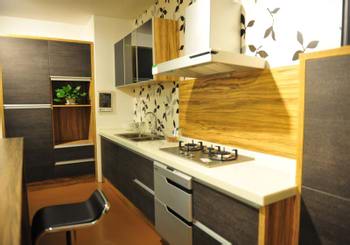 According to statistics from the Development Research Center of the State Council, the total capacity of the domestic market will reach 29 million units in the next five years, with an average of 5.8 million units per year; and in the 100 million urban households in China, the overall kitchen cabinet ownership rate is only 6.8%. Far less than the developed countries, the potential for the market is staggering. At the same time, after satisfying domestic demand, China's cabinets continue to increase their export intensity and become a big producer of cabinets, and they have shown a good development trend.
According to statistics from the Development Research Center of the State Council, the total capacity of the domestic market will reach 29 million units in the next five years, with an average of 5.8 million units per year; and in the 100 million urban households in China, the overall kitchen cabinet ownership rate is only 6.8%. Far less than the developed countries, the potential for the market is staggering. At the same time, after satisfying domestic demand, China's cabinets continue to increase their export intensity and become a big producer of cabinets, and they have shown a good development trend. “However, like other kitchen and bath products, China’s cabinets have to be truly international, and there are also many problems. The low level of industry, the competition for price reductions, and the lack of foreign-related talents have all become obstacles for enterprises. Now that China’s cabinet companies are As a result of springing up, especially under the stimulation of strong market demand in recent years, China has become one of the world's largest cabinet producers and its development speed has attracted worldwide attention, but domestic cabinet companies have not formed a strong brand in the international market. It is the pain of the whole cabinet industry." Yao Liangsong made an analysis.
Many consumers are still in the embryonic stages of production, craftsmanship, purchase and use of cabinets. There are many chaotic situations in the market where brands are numerous and mixed.
Yao Liangsong said that although China has become a big producer of cabinets, the road to branding in both domestic and international markets has only just begun. This means that China has to build a world of cabinet brands and still has a long way to go.
Why does the cabinet industry face the strong engulfment of foreign brands? Why does the cabinet industry face the challenge of the “global brand†at the beginning of his term of office?
In an interview with reporters, Yao Liangsong said: The "European Code Event" in 2006 has reminded us that there are many false propaganda about the so-called foreign brands, but consumers do not have a clear understanding of this. Understanding, this makes a lot of so-called foreign brands blind consumers in the consumer process. He thinks: "And the fact that many imported brands are no better than native brands in the product itself."
Yao Liangsong also used the footwear industry as an example to analyze: The lack of brand strength and core technology made the average unit price of China's footwear exports only 2.75 US dollars in 2006, while the unit price of imports was as high as 20.3 US dollars, and the export channel was also due to foreign The pressure of anti-dumping was forced to choose more re-export trade. “As an industry association, we cannot wear new shoes and take the old road. We have the obligation and responsibility to protect and cultivate our own world brand. First of all, we must have legal protection, and we must avoid 'Wahaha, Danone'. Astray, the child suddenly became a problem with his surname."
Innovation is the first productivity When it comes to the development of the cabinet industry in the future, Yao Liangsong said that China has developed into a world-leading manufacturer of cabinets. However, after careful analysis of the status quo of the development of China's cabinet industry, we found that the lack of innovation is a deadly obstacle to the further development of China's cabinet industry. He believes: "The independent research and development and innovation of China's cabinet brands, especially design innovation, are urgently needed."
The Stone Mosaics range consists of shaped slate pieces adhered to a mesh background. They are designed so that each tile interlocks with the others to create a seamless decorative finish.
A mosaic is a piece of art or image made from the assembling of small pieces of colored glass, stone, or other materials. It is often used in decorative art or as interior decoration. Most mosaics are made of small, flat, roughly square, pieces of stone or glass of different colors, known as tesserae. Some, especially floor mosaics, are made of small rounded pieces of stone, and called "pebble mosaics".
Stone Mosaic Patterns,Stone Mosaics,Mosaic Border Tiles,White Marble Mosaic
HEBEI DFL STONE , http://www.dflstone.com